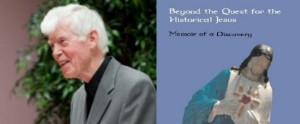 Continuing Thomas Brodie’s Beyond the Quest for the Historical Jesus: Memoir of a Discovery
Continuing Thomas Brodie’s Beyond the Quest for the Historical Jesus: Memoir of a Discovery
This post follows on from my earlier one on Chapter 9 that
- began with a discussion of my own on parallelomania,
- introduced Brodie’s desire to understand why the gospels appeared to use the Elijah-Elisha narrative as the framework for the life of Jesus,
- Brodie’s deepening understanding of the literary artistry and coherence of the Book of Genesis,
- and culminated in Brodie’s The Crucial Bridge, the hypothesis that the Elijah-Elisha narrative was an encapsulation of the larger themes of the Primary History, or Genesis to 2 Kings.
.
Chapter 10
From Homer to 4Q525: 1995-2000
.
Thomas Brodie continues with his biographical changes of circumstances that will segue into the establishment of the Dominican Biblical Institute, covered in chapter 11.
Among the snippets of interest for Brodie’s understanding of the Bible that emerge in this chapter:
- By concentrating on understanding Genesis in its final form rather than through seeking to identify its possible sources, Brodie began to see the whole book slowly taking on a coherent shape, thus losing its initial appearance of a series of awkwardly joined story-segments. The story of Abraham began with the themes of those two all-too-ephemeral values of beauty and wealth.
- The themes of duality in the Bible, discerned as early as the two creation stories of Genesis, are present even in the duality integral to the story of Elijah and Elisha. The same theme of heavenly focus balanced or set against the earthly plane is found in both. Indeed, it was work on Genesis that helped shape Brodie’s understanding of the Elijah-Elisha narrative, both in its episodic details and dual themes.
- “Michael Barré suggested that, like the ancient god Janus, the second creation account (Gen. 2.4b-24) is two-faced: it looks back to the first creation account, so that the two accounts form a pair, a diptych; but it also includes features that look forward to the account of the fall (Gen. 3).” (p. 97)
- Could or should Genesis be related at all to Homer’s epics, in particular the Odyssey? The character of Jacob appeared to mirror the essential qualities of Odysseus. But was not Homer too far removed from the Bible? Then Brodie learned that others had made similar observations linking Genesis to the Odyssey, and even between Jacob and Odysseus. But the notion of Homer-Bible relationship was prima facie too far removed from what was acceptable in Biblical studies. The Anchor Bible Dictionary said it all with its entry for Homer:
- HOMER . . . See WEIGHTS AND MEASURES.
Brodie confined his views on the Homer connection to an appendix in his Genesis as Dialogue:
The investigation of Genesis’ relationship to the Odyssey will require years of research — detailed analysis and thorough application of the criteria for [judging literary] dependence — and until such research is developed it is difficult to draw definitive conclusions. But, as with the case of Genesis and the prophets, there is already sufficient evidence to propose that Genesis’ use of Homer is a reasonable working hypothesis. (p. 96, citing Genesis as Dialogue, p. 492)
We know other scholars have since published on the relationship between Homer and both the New and Old Testament books. Brodie mentions Dennis MacDonald’s work on Homer and the Gospel of Mark, and himself writes of his belief that understanding these relationships might ultimately help us understand how the New Testament was written.
Matthew’s Logia and Qumran
In 1973 Brodie had proposed that we find in the Gospel of Matthew evidence for a source document that had been based on Deuteronomy and Sirach. This Sayings document, or Logia, was identified by Brodie through:
- Five Beatitudes (Mt . 5:5-9)
- Five Antithesis, plus a prologue and a sequel (Mt. 5:17-48 in parts)
- A Call/Song of Revelation/Wisdom (Mt. 11.25b-30)
The five beatitudes are the blessings upon the gentle, those who hunger and thirst after righteousness, the merciful, the clean of heart, and the peacemakers.
This is followed by a section on the Law. After the prologue (“Do not think I came to undo the law . . . “) we have a series of antitheses (“You have heard it was said of old, ‘You shall not kill . . . , But I say to you that all who are angry . . . ” etc.).
Then we have the cry of wisdom: “I thank you, father . . . for hiding these things from the wise and understanding and revealing them to infants. . . .”
In The Birthing of the New Testament Brodie explains that his argument that these passages point to an earlier source document is based upon:
- the same texts having a distinct literary relationship with Deuteronomy and Sirach
- the texts form a unity — with affinity to a Qumran document and the testimony of Papias
- the explanatory power of the thesis in understanding the development of the NT writings.
So it is of some interest that in 1988 and 1991 there was published (in varying degrees of completeness) a Qumran document that had been discovered in 1952 and that follows the same pattern.
The following translation is taken in large part from The Sacred Page blog, and I have highlighted the three-fold division Brodie points out by way of comparison with his own Logia document:
BEATITUDES
with a pure heart, and does not slander with his tongue.
Blessed are those who adhere to her laws, and do not adhere to perverted paths.
Bles[sed] are those who rejoice in her, and do not burst out in paths of folly.
Blessed are those who search for her with pure hands, and do not pursue her with a treacherous [heart.]
Blessed is the man who attains Wisdom,
LAW
and walks in the law of the Most High,
and directs his heart to her ways,
and is constrained by her discipline
and alwa[ys] takes pleasure in her punishments;
and does not forsake her in the hardship of [his] wrong[s,]
and in the time of anguish does not abandon her,
and does not forget her [in the days of] terror,
and in the distress of his soul does not loathe [her.]
For he always thinks of her,
and in his distress he meditates [on her, and in all his life [he thinks] of her,
[and places her] in front of his eyes in order not to walk on paths […]
[…] together, and on her account eats away his heart […]
[…] … and with kings it shall make [him s]it […]
[with] his [sc]eptre over … […] brothers … […]
[…]
WISDOM’S CALL
[And] now, sons [“children”], lis[ten to … and do] not reject […] […] … the evil of […]
The similarities are clear: it opens with beatitudes; the next section is a series of antitheses on the law, although here those antitheses are between obeying and not obeying; and it concludes (though most of the remainder is missing) with an apparently climactic call.
Brodie is not confident, however, that the Qumran document provided a specific model for what we read in Matthew. There was, Brodie points out, a great physical distance between the author of Matthew or his source and a copy of 4Q525.
But 4Q525 does provide an example of a form of writing that could have provided a general model for Sayings. (p. 100)
Thomas Brodie wrote to David Noel Freedman asking him if he would examine an extensive manuscript.
He agreed, and when he had received it, he sent a critique, and a general comment: ‘It is original, but not off the wall’. He also began to investigate how it might be edited and published. (p. 100)

If you enjoyed this post, please consider donating to Vridar. Thanks!

One thought on “Making of a Mythicist, Act 3, Scene 3 (“It is original, but not off the wall”)”